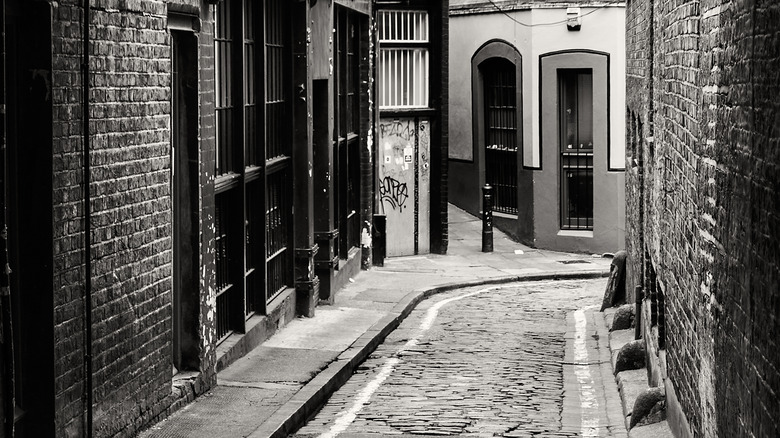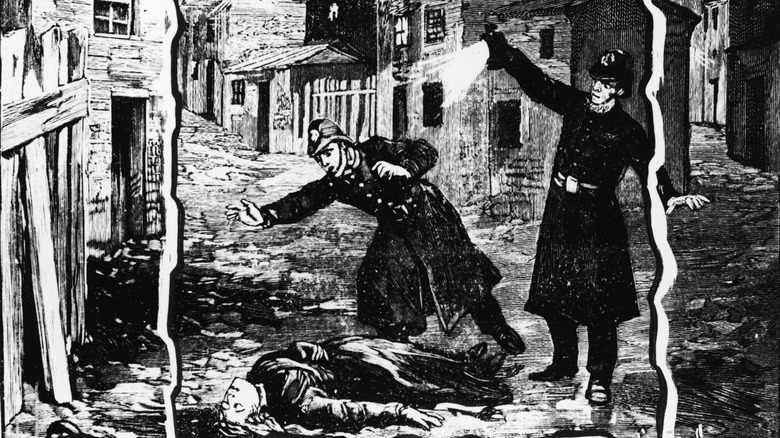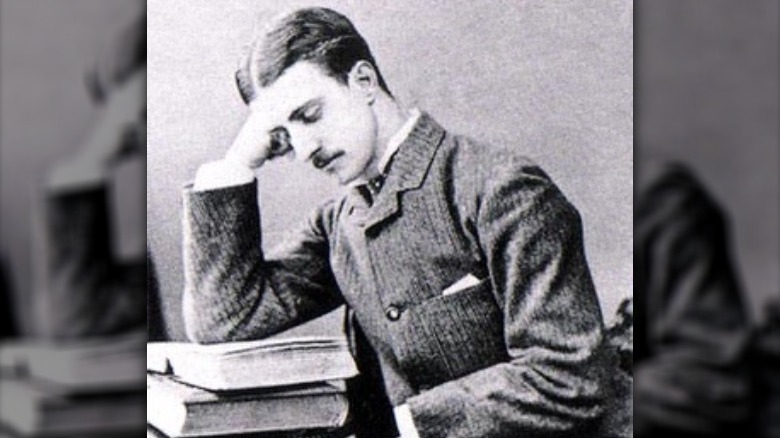Jack The Ripper's Infamous Nickname Came From An Utterly Dark Letter
In 1888, a series of grotesque murders terrorized those living in London's Whitechapel district. Five murders were eventually determined to be the work of one efficient, elusive killer and became known as the Whitechapel murders. However, these killings are better known today as the work of one of history's most notorious and mysterious serial killers: Jack the Ripper.
While over the years it has been claimed that Jack the Ripper could have been responsible for as many as a dozen murders, the "canonical five," as they came to be known (according to Britannica), are generally accepted as the murders most likely to have been committed by the same person. These occurred between August 31 and November 9, 1888, per the National Library of Medicine. Their killer's identity is unknown to this day. Sadly, the only name remembered in association with the crimes is not that of a victim, but a pseudonym chosen by someone who claimed to be the killer: Jack the Ripper.
The Whitechapel murders begin
In the London of Victorian England, Whitechapel was a rough part of town — overcrowded, impoverished, and riddled with crime. At night, Whitechapel's maze of filthy alleys and streets were lit only by gas lamps, giving a would-be murderer plenty of shadows to operate in virtually undetected. According to History, in the early morning hours of August 31, 1888, Mary Ann Nichols' body was discovered. She was the first victim to bear the signs now associated with Jack the Ripper: She was strangled, her throat had been cut, and she had been disemboweled, seemingly by someone well-versed in human anatomy (via All That's Interesting).
Contemporary reports labeled Nichols and the four subsequent victims as sex workers and that all of them except the final victim, Mary Jane Kelly, had been killed while soliciting on the street. In subsequent years, that assumption has been called into question. Police believed that the women had been offered money for sex, meaning that they willingly — and unknowingly — wandered off with their killer. Forensic science was a long way from where it is today, so investigators were limited to inspecting the victim's bodies and eyewitness statements from those who saw the victims shortly before their death. However, investigators also received an additional piece of evidence in the form of a series of letters thought to have been written and sent by the killer.
Jack the Ripper's name originated from a letter
According to History House, on September 25, 1888, the Central News Agency in London received a strange letter that came to be known as the Dear Boss letter, after the salutation the sender used. "Dear Boss," the letter opened. "I keep on hearing the police have caught me, but they won't fix me just yet." The letter writer then goes on to say how much they enjoy killing and plan to continue, even claiming to have saved some of their victims' blood in a gingerbeer bottle and had planned to use it as ink before it became too thick and unusable.
The letter is signed "Yours Truly, Jack the Ripper" and includes the postscript, "Don't mind me giving the trade name." At first, the letters were thought to be the work of pranksters, but they contained factual details, including one about cutting off the next victim's ears. That, combined with the timing of when the letters were sent, was enough for investigators to at least entertain the idea that the letters had come straight from the killer.
A postcard was sent a few days later, once again signed by Jack the Ripper. Some of these correspondences were printed in newspapers with the hope that they could draw out a lead, but that didn't happen. While some have claimed that Jack the Ripper was active until 1892, the final canonical murder was that of Mary Jane Kelly in November of 1888, per Britannica.
Who was Jack the Ripper?
The short answer is no one knows, but that doesn't mean there's a shortage of possible suspects. Arguably the most commonly suggested suspect is Montague Druitt. He was a barrister and the teacher was found dead after the final murders, something that would explain the abrupt end to the killing spree. He was known to have an interest in surgery — a tentpole of the killer's typical profile — and was thought to be mentally ill (via Britannica).
Another, more outlandish theory is that the killer could have been Lewis Carroll, the author of "Alice in Wonderland," but according to Literary Hub, while Carroll lived near Whitechapel, he was on vacation during four of the murders. Others have offered the explanation that the killer was actually American serial killer H.H. Holmes. Known for building a "murder castle" in Chicago, Holmes fits the profile, as he was known to have a fascination with human anatomy, according to Biography.
Another compelling theory is that Jack the Ripper may not have been a man at all. According to History, some have made the argument that Jack the Ripper could have been a woman, specifically one who worked as a midwife or an abortionist. Such a profession would have given her easy access to victims who would have trusted her and it would have meant that she possessed the anatomical knowledge the killer was thought to have. Plus, in Victorian England, a midwife could walk through the streets of London in bloody clothes without passersby even giving her a second glance (via All That's Interesting).



